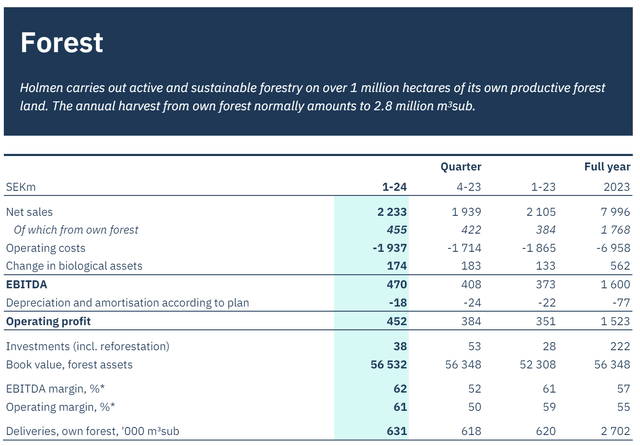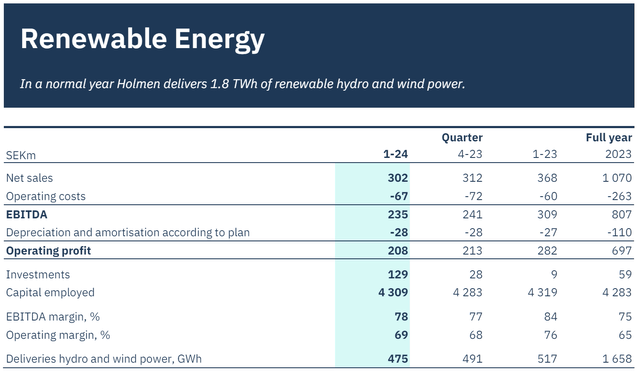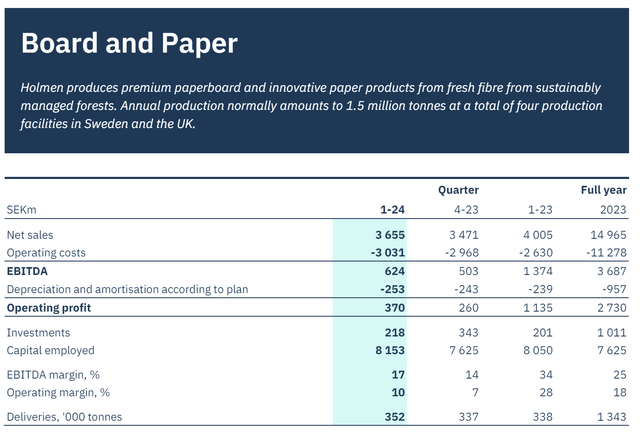Holmen (OTCPK:HLMMF) (OTCPK:HLMNY) (OTCPK:HLHLY) continues to benefit from timbre shortages as major exporters, Belarus and Russia, remain locked out of the market (discussed in last coverage). The forest business is therefore benefiting. Otherwise, capacity expansions are incoming to generate scale in the electricity generation business. Operational improvements have done something for the wood products business, but a turnaround is going to be needed in construction. In board and paper, we are past a shutdown that now leads to incremental profit gains, but overall end market demand is still weak. The EV/EBITDA multiple is above 10x, which in this environment means that expectations are still quite high and that a turnaround in the industrially facing businesses, and the capacity expansion, is probably already priced in.
Earnings Breakdown
Belarusian and Russian timbre aren’t permitted for import into the EU bloc, so there’s been a big shortage in the Baltic and Nordic markets. Therefore, prices of timbre continue to rise. While there is plenty of forest to sustainably take down, the issue is operational – no one is prepared to meet the demand shortfall. EBITDA rises in this segment YoY.
Forest (Q1 Press)
The wood products business has quite a lot of connection to local real estate markets and construction activity. Until recently, housing prices were under serious pressure in Sweden. Inflation remains quite high, but the general weakness in the Swedish economy is bringing on rate cuts. Inflation rates are making meaningful MoM declines. The rate cuts are more a reflection of the weak property markets, which are impacting household wealth, than some catalyst to reverse property market trends. There was already some emergence of peaking in the Swedish property market before the Ukraine war. In general, this dynamic of European markets having more space for rate cuts than the US reflects the ongoing pressures being sustained by the European economies, which have suffered more and benefited less from the realignment of supply chains.
Wood Products (Q1 Press)
Holmen is also in the renewable generation business, including hydro and wind. They also have nuclear capacity. The big expansions are coming in the Blisterliden Wind Farm, which is expected to grow overall production by about 20%. Electricity prices have, of course, been going down since the disruption caused by the Ukraine war last year. But the production increase should make a notable improvement, especially as electricity prices seem to be bottoming out in some, but not all, markets.
Renewable Energy (Q1 Press)
Pulp and paper now benefited from renewed production, where it was doing some planned shutdowns and maintenance, and general reopening with certain paper grades seeing some recovery, particularly office paper. Incrementally, there have been some declines in paper, but at least board destocking is over, which is allowing prices to recover. Demand continues to be weak, but it’s not declining anymore. Prices are down because energy inputs are down, but margins still declined. Some permanent capacity reductions have started, which will put a bottom on paper prices. But things are not particularly good for European producers. There could be some more margin declines, as we are still far off longer-term levels, which were considerably lower on account of longstanding lows in energy prices. Energy prices are higher now, so current price levels are probably closer to the bottom. The issue is demand, which could continue to decline if we see more pronounced recessionary pressures.
Board and Paper (Q1 Press)
Bottom Line
A decent comp is SCA (OTCPK:SCABY). We think that we can be conservative and annualise current figures. We don’t have high hopes for the economy, and expect incremental improvement to be limited in most businesses. We do want to add the effects of a 20% production increase in the renewable business, but it only comes online in 2026. On a relative basis, if you annualise Holmen figures you get something pretty similar to forward multiples to SCA, so there really isn’t a relative value case at around 14x EV/EBITDA. The problem is: We don’t like anything above 10x EV/EBITDA, especially if there aren’t clear positive drivers. Forestry is fine, but the other segments are still under significant pressure. A pass.
Editor’s Note: This article discusses one or more securities that do not trade on a major U.S. exchange. Please be aware of the risks associated with these stocks.
Read the full article here












